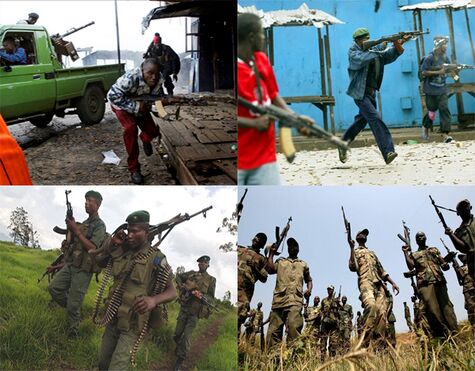Lyoan Civil War
This article is incomplete because it is pending further input from participants, or it is a work-in-progress by one author. Please comment on this article's talk page to share your input, comments and questions. Note: To contribute to this article, you may need to seek help from the author(s) of this page. |
| Lyoan Civil War | |||||||||
|---|---|---|---|---|---|---|---|---|---|
 (clockwise from top left) Revolutionary United Forces rebels fighting during the Battle of Tigera.
| |||||||||
| |||||||||
| Belligerents | |||||||||
|
|
|
| ||||||
| Commanders and leaders | |||||||||
|
Carl von Rosen |
Marcil Yantanda Kemoh Foday Travis Hume |
Emmerson Mponda Joshua Pierre Hagando Gavril Vassili |
Thomas Radinka Ikovle Volvakov | ||||||
| Strength | |||||||||
| ~90,000 (1998) | ~30,000 (1999) | ~28,000 (1999) | ~25,000 (1998) | ||||||
| Casualties and losses | |||||||||
|
Between 60,000-350,000 killed 1+ million displaced | |||||||||
The Lyoan Civil War (1998-2003) was a major civil war in Lyoa that began on 10 August 1998 when military defectors formed the Democratic Army of Lyoa to overthrow the government of Laurent Tulossa. The war lasted for over 4 years, and ended with the signing of the Orléans Peace Accords in August 2003. By the conflict's end, well over 60,000 had been left dead. Hostilities have continued since the Eastern and Northern conflicts.
The conflict saw the rise of three major rebel armies, who were all at odds with each other in addition to the government. The first of these rebel movements was the Democratic Army of Lyoa, which began the civil war. Shortly after, the Nationalist Front and Revolutionary United Forces arose and began challenging the government and Democratic Army. By 2000, the government only held 1/4 of the country, although control was limited outside of major cities.
In late 2002, the Revolutionary United Forces closed in on Tigera and managed to take the city, ending the government of Tulossa, who had already fled the country. Conflict between rebel groups continued until August 2003, when a peace accord was finalized in Orléans, Quebecshire. The agreement set up democratic elections, and integrated the rebel groups as political parties, and integrated their soldiers to the military.
Causes of the War
Politics
Laurent Tulossa became president of Lyoa in 1979, following a coup d'état that ousted the government of James Sharokoh, which was widely regarded as incompetent. Tulossa's coup was originally seen as a positive, as Lyoa's economy began to improve, as well as general living conditions in the country. This era, known as "Tulossa's Golden Age" lasted until 1990.
Following the end of the "Golden Age", Tulossa's administration was heavily criticized by Lyoans, who had believed that Tulossa would implement democracy. Instead, the government became increasingly totalitarian, with many old state institutions being abolished, and more power being given to Tulossa and the executive branch. The government began to suppress criticism, and arrested many opposition leaders, causing widespread protests and a significant drop in Tulossa's popularity by 1996.
Resources
The Eastern and Northern regions of Lyoa, where the conflict began, are rich in natural resources. These include diamonds, gold, uranium, and coltan. Control of these resources is what has allowed Lyoa to prosper in the past, able to effectively control the extraction and exportation of them. This has caused severe tensions; however, as local leaders and civilians wish for greater control over resources in their areas, and some wish for total control over mining. This fueled the Lyoan Civil War as it became a profitable endeavor to fight for control over mining areas.
Foreign Involvement
Some researchers allege that the involvement of foreign powers is partially to blame for the beginning of the war. It is believed that some foreign powers funded rebel groups early on, or encouraged the creation of the Democratic Army for reasons unknown. Those who believe this theory allege that foreign nations wished to exploit Lyoa's resources for their own gain.
1998
The war began after several brigades of the Lyoa National Defense Force defected to form the Democratic Army of Lyoa. Its leader was Emmerson Mponda, a Colonel in the Lyoa National Army before his defection. The declaration of rebellion came on August 10th, and the rebels began to seize towns in the east of Lyoa. Kabule, the most populous city near the border, was captured in a matter of days. This is where the Democratic Army would base their operations for the rest of the war.
The quick advance of the rebels frightened the government, who contracted mercenaries from Paleocacher to assist the LNDF in putting down the rebellion. Mercenary use would become a staple in the war, with all sides contracting mercenaries from across the globe. On August 25th, the first batch of mercenaries arrived to assist the government, the same day that the First Battle of Timbao took place. The Democratic Army attacked the LNDF in Timbao, nearly overwhelming them before mercenaries arrived to bail out government forces that night. The same day, a rocket attack along the front line hit a house, killing a family inside of it. The Democratic Army's advance continued until the end of the month, where they declared a brief ceasefire. This was broken when they launched an attack on Timbao. The resulting battle lasted three days before government forces withdrew.
September opened with a government offensive against the rebels, but this largely failed and was only able to recapture a few villages and towns. Rebel forces captured the mining site of Tikando on September 13th, and launched mortars at government troops the same day. Midway through September, mercenaries from Xusma appeared fighting on the side of the rebels, and it is believed famous Xussman mercenary leader Ikovle Volvakov was commanding them.